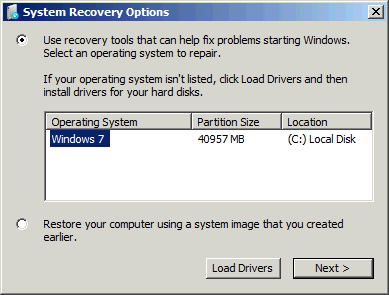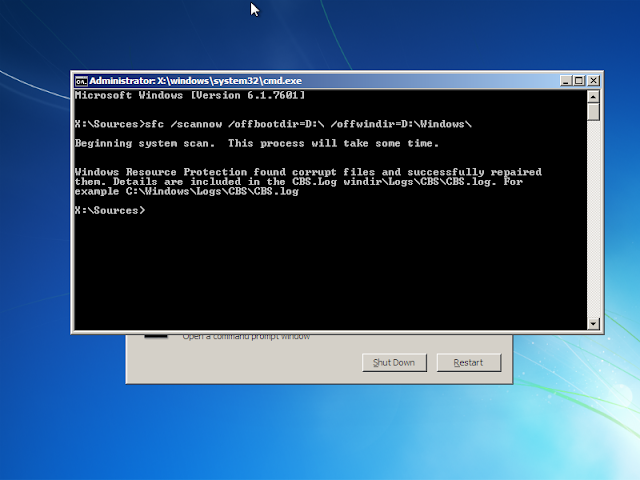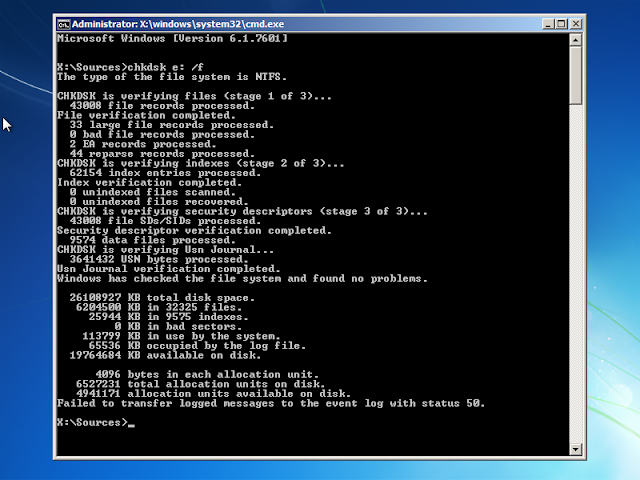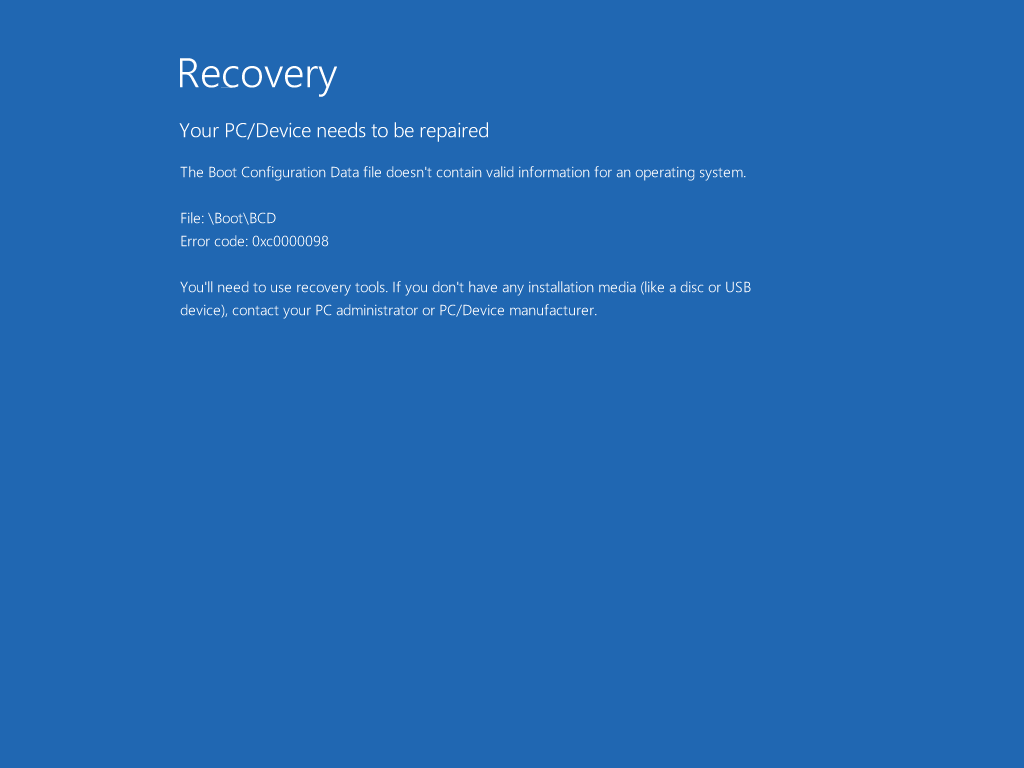Get the fix to the 0xc0000098: The Windows Boot Configuration Data file does not contain a valid OS entry
boot error message affecting Windows Vista, Windows 7, 8, 8.1,10,11 .
Description and Symptoms
The error messages, alerts, warnings, and symptoms below are tied to this error.
As a part of the system startup procedure, the BOOTMGR bootloader introduced in Windows Vista and subsequently used in Windows 7, Windows 8(.1), and Windows 10 uses a database of entries and configuration options known as the BCD, which acts as a global store for all boot-related options and settings on newer Windows PCs. However, if the BCD file has no operating system entries, then the following error message will appear:

Windows failed to start. A recent hardware or software change might be the
cause. To fix the problem:
1. Insert your Windows installation disc and restart your computer.
2. Choose your language settings, and then click "Next."
3. Click "Repair your computer."
If you do not have this disc, contact your system administrator or computer
manufacturer for assistance.
File: \Boot\BCD
Status: 0xc0000098
Info: The Windows Boot Configuration Data file does not contain a valid
OS entry.
On newer Windows systems, the error screen looks a little different:

Recovery
Your PC/Device needs to be repaired
The Boot Configuration Data file doesn't contain valid information for an operating system.
File: \Boot\BCD
Error code: 0xc0000098
You'll need to use recovery tools. If you don't have any installation media(like a disc or USB device), contact your PC administrator or PC/Device manufacturer.
A device driver that’s incompatible with your Windows system can cause this error too. In this kind of example, the error text can mention a specific file at the File row:
Windows failed to start. A recent hardware or software change might be the
cause. To fix the problem:
1. Insert your Windows installation disc and restart your computer.
2. Choose your language settings, and then click "Next."
3. Click "Repair your computer."
If you do not have this disc, contact your system administrator or computer
manufacturer for assistance.
File: \Windows\System32\Drivers\aswVmm.sys
Status: 0xc0000098
Info: Windows failed to load because a critical system driver
is missing, or corrupt.
Causes of this Error
This error has been known to occur as a result of one or more of the following:
Cause 1: BCD has no OS entries
One of the most common causes of this error is the BCD that has no entries in it. That could happen because of disk write errors, power outages, boot sector viruses, or errors made while configuring the BCD manually.
Cause 2: An incompatible hard drive driver is installed
Another possible cause of this error is a device driver that is incompatible with the current hard drive. That could occur after a system update, or a service pack installation.
Fixing “0xc0000098” on Windows
Windows Setup CD/DVD Required!
Some of the solutions below require the use of the Microsoft Windows setup CD or DVD.
Fix #1: Run Startup Repair
On Windows Vista, Windows 7, Windows 8 and Windows 8.1, Startup Repair can be used to scan the system for damaged or missing system files to replace the BCD file if it has no entries.
Windows Setup CD/DVD Required!
Some of the solutions below require the use of the Microsoft Windows setup CD or DVD.
Startup Repair is an automated diagnosis and repair tool that is available from the Windows setup disc and can be used to find and repair some common problems. More information about how Startup Repair operates and what it does can be found in our knowledge base. The following steps will initiate Startup Repair from the Windows setup disc:
- Insert your Windows installation DVD into your PC’s CD-ROM drive,
- Fully power down your PC, and make sure it has fully shut off,
- Power up your PC,
- Press any key when you see “Press any key to boot from CD or DVD..”
- Click the link titled “Repair your computer” in the bottom-lefthand corner, after first selecting your language and keyboard options.

- Wait for Startup Repair to scan your PC for Windows installations, then select your install from the list it shows:

- Wait for Startup Repair to scan your PC for Windows installations, then select your install from the list it shows:

- Startup Repair will begin scanning your installation for known issues and will attempt a repair, if possible.

Here is an example of what the PC’s startup repair should look like once the BCD file is properly restored:

Empty BCD file restored by Startup Repair
Fix #2: Rebuild the BCD manually
Since the boot error is often caused by an empty BCD file, rebuilding it is often a good solution.
Here are the steps to rebuild the BCD:
- Boot from the Windows install disc
- Click on Repair your computer after selecting proper language, time and keyboard input.
- Select the Windows installation drive, which is usually
C:\and click Next - Choose Command Prompt when the System Recovery Options box appears
- Write the following command and press
Enterafterwards:
bootrec /rebuildbcd
- If the program finds a Windows installation and asks whether it should add it to the boot list, press
Y
Here is an example screenshot of what the PC’s console output should look like once Bootrec is done rebuilding the BCD.

Fix #3: Run sfc utility
On Windows Vista and Windows 7, it is possible to use the built-in Windows SFC(system file checker) tool to automatically scan a computer’s system files and repair them if necessary.
On Windows Vista and Windows 7, it is possible to use the built-in Windows SFC(system file checker) tool to automatically scan a computer’s system files and repair them if necessary.
Here are the steps to run SFC:
- Boot from your Windows install disc
- Click on Repair your computer after selecting proper language, time and keyboard input.
- Select the Windows installation drive, which is usually
C:\,and click Next - Choose Command Prompt when the System Recovery Options box appears
- Write the following command and press Enter afterwards:
sfc /scannow /offbootdir=D:\ /offwindir=D:\Windows\Replace D: with the letter of the driver where Windows is installed, and D:\Windows with the Windows folder location.
Here is an example of what the PC’s console output should look like once the sfc.exe scan is complete and missing files are successfully restored:

Fix #4: Check your disk with CHKDSK utility
If the hard drive has its file integrity compromised, it is possible to use built-in Windows CHKDSK utility to scan the disk and fix the file system errors.
Here are the steps to run CHKDSK:
1. Boot from your Windows install disc
2. Click on Repair your computer after selecting proper language, time and keyboard input.
3. Select the Windows installation drive, which is usually C:\, and click Next
4. Choose Command Prompt when the System Recovery Options box appears
5. Write the following command and press Enter afterwards:chkdsk C: /fReplace C: with the letter of the driver where Windows is installed.
Here is an example of what the PC’s console output should look like once the chkdsk.exe is complete:

Thank you
please give me a comment or like this article if it is useful for you 🙂




